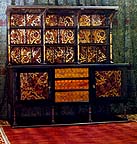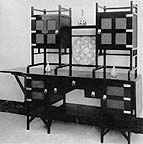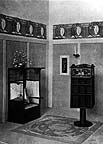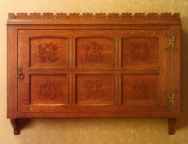Furniture becomes lighter again
By the 1880's, heavily carved, ponderous furniture was being replaced by lighter designs, often inlaid with marquetry. Rather flimsy bamboo furniture became fashionable, while Japanese screens and Oriental trifles, blue and white china, sunflowers and peacock feathers, joined the crowd of ornamental odds and ends. Meanwhile, the habit of collecting antique furniture had degenerated into a form of mania with many people, and was indirectly stimulated by the deliberate mediaevalism of the handicraft revival. [Gloag, p. 42]

|

|

|

|

|

|

|

|

|

|

|

|

|

|

|

|

|

|

|

|

|
Related Materials about Victorian Furniture
- Furniture that gave Victorian style a bad name
- One Reaction: Gothic Furntiture
- Art Furniture -- Sofas and Chairs
- Art Furniture -- Tables
- Art Furniture -- Pianos
- Bibliografía
Bibliografía
Cumming, Elizabteh, and Nancy Kaplan. The Arts and Crafts Movement. London: Thames and Hudson, 1991.
Naylor, Gillian. The Arts and Crafts Movement: A Study of Its Sources, Ideals, and Influence on Design Theory. Cambridge: MIT Press, 1971.
p class="bibl"> Gloag, John. Victorian Comfort: A Social History of Design, 1830-1900. A. C. Black, 1961. (Reprinted 1973 by David and Charles, Newton Abbot.)Wainwright, Clive. Introduction. Architect-Designers from Pugin to Mackintosh. Exhibition catalogue. London: The Fine Art Society with Haslam & Whiteway Ltd., 1981.
Skipwith, Peyton. Holy Trinity, Sloane Street. London: The Trinity Arts and Crafts Guild, 2002.
<
Modificado 22 febrero 2004; traducido 16 de enereo de 2010